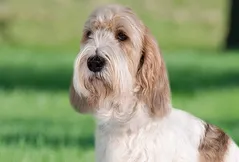
Bloodhound
Bloodhound is tough, stubborn and independent, yet it is so gentle and placid that it is extremely trustworthy around children.
Overall Status
| Height | 23 to 27 inches at the shoulder |
| Temperament | Friendly, Independent, Inquisitive |
| Weight | 80 to 110 pounds |
| Life Expectancy | 8 to 10 years |
| Coat Color | Black and Tan, Red |
| Barking Level | Frequent |
Quick Factors
| Playfulness | |
| Dog Friendly | |
| Exercise Need | |
| Grooming Needs | |
| Strangers Friendly | |
| Family Affectionate |
Daily Care
Grooming Tips
Bloodhounds require a lot of grooming to remain healthy. They shed lightly throughout the year, and heavier during the change in season. Weekly brushing can keep shedding under control. A hound mitt is recommended for brushing, as this breed has thin skin and requires a gentle touch.The folds of the Bloodhound's skin should be wiped out daily with a damp cloth in order to prevent bacterial infections. Don't forget to dry afterward. The flews – the part of the upper lip that hangs – also need to be wiped out after mealtime.Bloodhounds are very prone to ear infections, thanks to their heavy, dropped ears which allow for virtually no air circulation. Use a veterinarian-recommended cleaning solution every week to make sure harmful bacteria does not build up. They are also prone to bad breath and rotting teeth, so daily or weekly brushing of the teeth is required.
Exercise Tips
The popular misconception is that Bloodhounds spend their days lazing on the front porch. The truth is that the Bloodhound, who was bred to follow a scent for hours on end, is an active dog who requires dailyexercise.He will benefit from long daily walks—always on a leash, as he may not respond to commands if he has found a scent to follow. Additional exercise time can come in the backyard, which must be securely fenced because Bloodhounds are great diggers and escape artists.
Feeding Tips
Bloodhounds have a droopy face and ears, so it’s important not to give them a diet full of messy food that can get stuck in the creases of its face.A normal dog’s diet of meat and whole ingredients like vegetables and potatoes can really give your Bloodhound plenty to chew on. Be sure to incorporate treats as part of its diet, rationing them so you don’t overfeed them while training.
Health Tips
Like other large, deep-chested dogs, Bloodhounds can experiencebloat. Bloodhound owners should educate themselves to recognize the symptoms of this life-threatening condition, and know what to do should it happen.Bloodhounds are notorious for eating anything and everything, which can often lead to vet visits. The Bloodhound’s low-hanging ears should be checked daily for any sign ofinfection.In addition, check the Bloodhound’s skin wrinkles daily for odor or irritation, and if needed wipe with a warm, wet cloth and then dry thoroughly. As with all breeds, a Bloodhound’s teeth should be brushed regularly.
Trainability
As with all breeds, earlysocializationandpuppy training classesare recommended. With a Bloodhound, it’s best to start obedience classesearly; they tend to become set in their ways, and it’s better if the behaviors they hold onto for a lifetime are the behaviors the owner wants.Bloodhounds like to take charge, so an owner needs to be firm but kind. Training that involves positive rewards, such as treats and praise, is usually effective. The Bloodhound is affectionate and devoted and also stubborn and independent, so his training requires patience, consistency, and skill.
History
Dogs like the Bloodhound have been in existence for centuries, used by noblemen to track game in the ritual of the hunt. Today’s Bloodhound descends from the St. Hubert hound, created in eighth-century France to follow difficult trails in search of the treacherous game such as wild boar.William the Conqueror brought St. Hubert hounds with him when he conquered England in 1066, and it was there that the Bloodhound eventually blossomed, some 800 years later.The Victorians were famous for creating dog breeds as we know them today — previously there had been no breed standards and rarely any record keeping of bloodlines. The rise of dog shows and widespread interest in the keeping of fine or rare animals helped to save many breeds from extinction. The Bloodhound was one of them.His ability as a man trailer, and the patronage of Queen Victoria, herself a noted dog lover, saved him from fading into oblivion. Mantrailing with Bloodhounds became a popular leisure activity, and it didn’t take long before the police recognized the Bloodhound’s usefulness in tracking down criminals.These days, the Bloodhound is still a favored member of many law enforcement teams. His testimony is even accepted in court.






